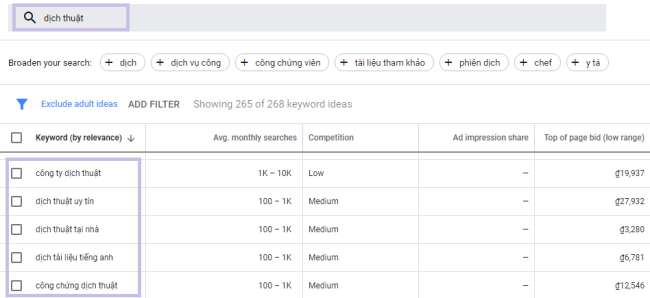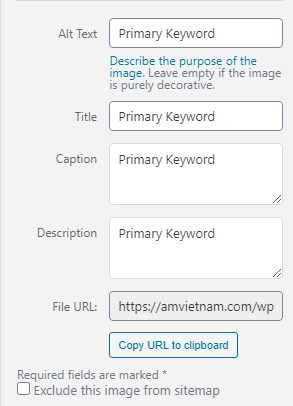You have put a lot of effort into creating a quality article for your company’s website. Now you will definitely want that article to be known by many people to improve the performance and reputation of your company. To make this come true, you need to know a little more about how search engines like Google, Bing or Yandex assess the content of your articles. The following tips shall help you naturally improve your ranking on those search engines.
34 Tips for SEO-friendly Articles
#1. Write a title for your article.
Specify the correct title for your article. That title will help you stick to the topic and ensure consistent content. It should also be attractive to your audience and reflect the content of the article.
#2. Determine your audience.
Specify the target audience of your article. Do you want to write articles for young people, for customers who want to learn about your products, or simply for the community in general? This will help you choose the right words.
#3. Know your purposes.
Every digital content needs to be created based on a specific marketing plan. So, one of the first things to do is to set goals for your article. For example, building brand identity, getting email subscribers, improving efficiency in SEO, etc.
#4. Choose your main keyword.
You will not be able to optimize an article without main keyword. Choose the best keyword for your article. This keyword needs to accurately represent the topic of the article and should be one of the most popular keywords in the industry/relevant fields. You can use a keyword research tool like Google Keyword Planner to choose the right keyword.

#5. Use the main keyword in your title.
Review your title to make sure it includes the main keyword.
#6. Choose a few extra keywords.
A good article often contains a few extra keywords to supplement the main keyword. Pick a few related keywords (LSI keywords – Latent Semantic Indexing). These keywords can reduce the main keyword density, making your article more natural. From a SEO perspective, they will help search engines find out easily what your article is about.

#7. Write at least 300 words.
You can write as long as you need to fully solve a given problem. Typically, an article needs to be at least 300+ words long for search engines to understand that your article has content “worth” reading.
#8. Provide useful information.
When writing articles, try to provide detailed information such as figures, news, and facts that is useful to your audience.
#9. Illustrate.
It’s important to note that the article should provide examples and illustrations to help readers understand thoroughly and easily grasp what you are trying to convey.
#10. Use active voice.
Make your article interesting using active voice. Avoid passive voice, since your audience may think that the content of your article is dull and monotonous.
#11. Ensure readability.
You need to make sure the article is of high quality, but using simple language. Avoid complex sentences or terminology so as not to reduce the number of readers.

#12. Avoid copying content.
You need to write your own content, do not copy articles from other websites. Plagiarism can result in penalties and lower ranking by search engines for your website.
#13. Cite sources properly.
If your article contains citations or information from other pages, don’t forget to cite the sources and link to the original content.
#14. Use subheadings.
Divide your article into different sections using subheadings. This will make it easier for readers to follow the article.
#15. Use the main keyword in subheadings (at least once).
To increase the SEO score of your article, include the main keyword in at least one of your subheadings.
#16. Split long paragraphs.
To ensure readability, you should not write a too long paragraph, but dividing it into shorter paragraphs. Typically, an ideal paragraph should be 5-7 lines in length.
#17. Emphasize important information.
One of the best tips to optimize your article is to use formatting functions to highlight important information for quick grasp. You can bold, italicize or use other formatting functions to emphasize important information in your article.
#18. Add graphics.
You can add images, videos, embedded posts on social networks, etc. to increase the appeal or interactivity of your article.
#19. Make sure your image size is appropriate.
Images that are too large will slow down the page loading speed. So be careful not to use images that are too large.
#20. Include the main keyword in the alt text of an image.
The alt text of an image should also contain the main keyword to increase the SEO score of the article.
#21. Use the main keyword in image file name and image title.
When inserting an image into your article, you should use the main keyword as the image file name and image title.

#22. Avoid copyrighted photos.
For each photo/video used in the article, you need to double check to see if you have the right to use them to avoid copyright infringement.
#23. Use the main keyword in page title.
This is also one step towards SEO. Usually, you can use the article title as the page title.
#24. Use the main keyword in the meta description.
You can summarize the content of your article here. Include your keywords cleverly and write no more than 160 characters in the meta description.

#25. Use the main keyword in the first paragraph.
One way to optimize your article and increase your SEO score is to include your main keyword in the first paragraph. This is a way to send signals to site crawlers. The first paragraph is often the introduction as well, it helps the audience understand the what the article is all about.
#26. Repeat the main keyword at the end of the article.
Similar to the introduction, your article needs a conclusion paragraph that summarizes the main content of the whole article. Don’t forget to include the main keyword in this paragraph.
#27. Use your main keyword naturally.
Keyword repetition doesn’t mean keyword stuffing. Keyword stuffing can result in penalties and lower ranking. Use your main keyword where appropriate. Typically, an optimized article will have a keyword density of around 2%.
#28. Add links to related pages.
Check if there is any relevant article among your previous ones or if there is any page partially/entirely related to your new article, and place appropriate links to those pages.
#29. Set up to open link in new tab.
This allows readers to stay on your page when a link in the article is clicked. The linked page will be opened in a new tab.
#30. End it with “Call To Action”.
Remember the original goal of the article and suggest customer’s next action.

#31. Write more to complete your title.
Back to the article title, you can create more titles and choose the best one among them. Make sure your title contains keywords, is short and appeal. The length of the title should not exceed 60 characters to be fully displayed in the search results.
#32. Optimize by social sharing.
Encourage readers to share your articles by creating sharing links to Tweeter, Facebook, etc.
#33. The last editing.
Double-check your article one last time before publishing it, make sure it’s free of spelling or grammatical errors.
#34. Check your SEO score.
Before publishing the article, make sure all SEO steps have been implemented for the best possible SEO results.
Above are 34 things to note for your article optimization. Make sure you clearly know what your article is for from the very beginning and include it in an overall marketing plan. You can also consider multilingual content. A high-quality article can be even better when delivered in multiple languages. So, consider localizing or globalizing your content to easily reach your target market.
(***Learn more about 10 reasons why you need a multilingual website)


